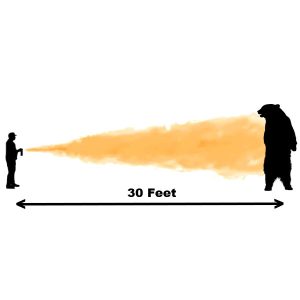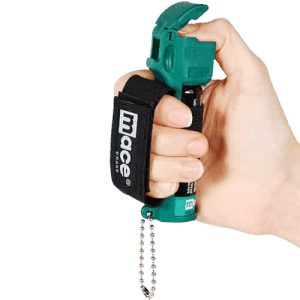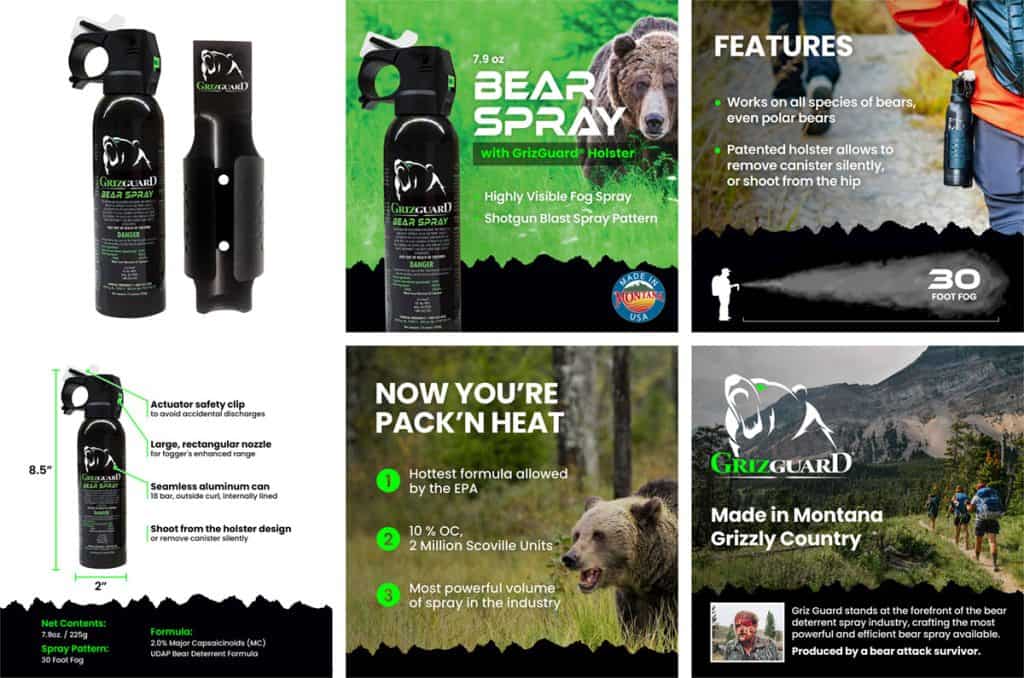If you want to stay safe outdoors, consider using animal-repellent pepper sprays. These sprays contain oleoresin capsicum (OC), a compound from hot peppers. This compound attacks the mucous membranes of animals, making them feel a burning sensation and causing temporary blindness. That’s why it’s a dependable method to keep wildlife at bay.
Bear sprays pack a punch! They boast a high OC concentration and impressive reach, which makes them super effective! On the flip side, we have dog sprays. They’re different because they have a lower concentration. That’s done on purpose so they can stop dogs without causing them any long-term harm.
Don’t forget that knowing the safety rules is crucial. You need to learn how to aim the spray correctly. Also, look at product reviews before you buy. If you understand these points, you can enhance your outdoor safety gear effectively.
Key Takeaways
- Bear deterrent sprays are potent and have an extended range, which is ideal for large animal encounters.
- Dog repellent sprays have lower concentrations and are suitable for deterring aggressive dogs without lasting harm.
- Capsaicinoid concentration between 1-2% is effective against wildlife, including bears and dogs.
- Pepper sprays target mucous membranes, causing burning sensations and temporary blindness for quick deterrence.
Understanding Animal Behavior
 Knowing how to use animal-repellent pepper sprays effectively is crucial. It requires an understanding of animal behavior in various situations. Often, animals react based on their instincts. These instincts can make them defensive or even aggressive, especially when you invade their territory. For instance, if you bump into a bear unexpectedly, it might view you as a threat. This situation could trigger its natural fight-or-flight response.
Knowing how to use animal-repellent pepper sprays effectively is crucial. It requires an understanding of animal behavior in various situations. Often, animals react based on their instincts. These instincts can make them defensive or even aggressive, especially when you invade their territory. For instance, if you bump into a bear unexpectedly, it might view you as a threat. This situation could trigger its natural fight-or-flight response.
Understanding territorial behavior is key. Many animals, such as wolves and cougars, stake out and defend their territories. If you inadvertently cross into their space, they may react aggressively to protect it. Recognizing signs of territorial behavior, like marked trails or frequent sightings, can help you identify when you’re entering an animal’s territory.
To use pepper sprays safely, you need to understand certain behaviors. A quick assessment of the situation is crucial. Determine if an animal’s behavior is defensive or territorial. For instance, if a moose charges at you, it’s probably trying to protect its young. You’ll need to react appropriately in such situations.
How Pepper Sprays Work
Pepper sprays pack quite a punch! They send out a powerful, irritating compound that messes with an animal’s eyes, nose, and breathing. This causes instant discomfort and stops any more aggression. Want to know the secret ingredient? It’s oleoresin capsicum, or OC for short. We get this stuff from hot peppers. You see, OC sparks a big inflammation response, making pepper sprays super effective.
When you use the spray, it hits the animal’s mucous membranes with a fine mist, causing strong burning sensations. The animal’s eyes will probably swell up, and it might not be able to see for a while. Its nose will get inflamed, which makes it harder to breathe. The animal might cough or choke. These reactions happen immediately, usually just a few seconds after the spray hits. This quick response makes the spray more effective.
Research shows that pepper sprays work well against many animals. Bears, dogs, and big cats, for example. The amount of OC in the spray can change, but usually, the more OC, the stronger the spray. The way the spray comes out, how far it goes, and how long it lasts are also important. They can make the spray work better or worse. Always make sure you know all about your pepper spray. This way, you’ll get the most out of it.
Types of Pepper Sprays
When choosing a pepper spray for animal repellent, you’ll mainly encounter two types: bear deterrent sprays and dog repellent sprays. Bear deterrent sprays are designed for high potency and extended range, making them effective against large animals. Conversely, dog repellent sprays typically have a shorter range and lower concentration, which makes them suitable for deterring aggressive dogs without causing lasting harm.
When you’re picking out a pepper spray to repel animals, you’ll mainly come across two kinds: sprays for deterring bears and sprays for repelling dogs. Bear deterrent sprays pack a punch and have a long range, which makes them great at scaring off big animals. On the other hand, dog repellent sprays usually don’t reach as far and aren’t as strong. This makes them perfect for shooing away aggressive dogs without hurting them in the long run.
Bear Deterrent Sprays
 Bear sprays with capsaicin really stand out among the best. They can stop aggressive bears in their tracks and fast. We know they work well because of many studies. These studies show that bear spray can lower the chance of getting seriously hurt during a bear encounter by more than 90%. That’s why it’s a must-have tool for anyone heading into bear country. Capsaicin is the stuff in the spray that does the job. It quickly irritates a bear’s eyes, nose, and lungs. This gives the bear a solid reason to back off.
Bear sprays with capsaicin really stand out among the best. They can stop aggressive bears in their tracks and fast. We know they work well because of many studies. These studies show that bear spray can lower the chance of getting seriously hurt during a bear encounter by more than 90%. That’s why it’s a must-have tool for anyone heading into bear country. Capsaicin is the stuff in the spray that does the job. It quickly irritates a bear’s eyes, nose, and lungs. This gives the bear a solid reason to back off.
To ensure you’re always ready for a surprise bear visit, you must become skilled at using bear spray. Always have it handy, like in a holster on your belt or on a backpack strap. When using bear spray, aim it at a downward angle. This creates a cloud between you and the bear. Even if the bear decides to charge, the spray will still work. If you practice these tips often, you’ll feel safe and prepared for any situation.
Remember to check your bear spray’s expiration date and replace it if it’s past due. An out-of-date spray may not be as strong, making it less effective. Stick to these rules, and you’ll boost your safety on your outdoor trips.
Dog Repellent Sprays
 Bear deterrent sprays keep you safe in the wild, but dog repellent sprays are for city and suburb encounters. They’re made to tackle problems like dog attacks that can be a risk when you’re doing everyday things like walking or jogging. Knowing about the different kinds of dog repellent sprays can help you pick the right one for you.
Bear deterrent sprays keep you safe in the wild, but dog repellent sprays are for city and suburb encounters. They’re made to tackle problems like dog attacks that can be a risk when you’re doing everyday things like walking or jogging. Knowing about the different kinds of dog repellent sprays can help you pick the right one for you.
Dog-repellent sprays usually contain pepper-based ingredients. These ingredients help temporarily keep aggressive dogs away without hurting them in the long run. If you often encounter stray or unleashed dogs, these sprays can be very helpful. For example, if you’re leash training your dog, having a repellent spray can protect you from sudden aggressive dog encounters.
Research shows that capsaicin, usually the active ingredient in these sprays, can stop a dog in its tracks. But remember, you should only use these sprays as a last resort. You can’t replace good old-fashioned dog training and socializing. Also, don’t forget to check and follow your local rules about using these sprays.
Benefits of Use
Animal-repellent pepper sprays offer a reliable way to protect yourself and your property from unwanted wildlife encounters. Numerous effectiveness studies have shown that these sprays can deter various animals, from aggressive dogs to curious bears. These studies highlight how the active ingredients, usually capsaicin, and related compounds, create an immediate and painful reaction in the animal, forcing it to retreat.
User testimonials further support these findings, with many outdoor enthusiasts and homeowners sharing their positive experiences. They often emphasize the ease of use, portability, and instant results of these sprays. Whether you’re hiking in Bear Country or trying to keep raccoons out of your trash, animal-repellent pepper sprays provide a practical and efficient solution.
Additionally, these sprays are non-lethal, making them a humane option for wildlife control. They don’t cause permanent harm to the animals but effectively discourage them from returning. This humane aspect is particularly important for those who care about animal welfare while still needing to guarantee their safety.
Safety Tips and Precautions
 Follow some essential safety tips and precautions to guarantee the effective and safe use of animal-repellent pepper sprays.
Follow some essential safety tips and precautions to guarantee the effective and safe use of animal-repellent pepper sprays.
First, familiarize yourself with local safety regulations regarding the use of such sprays. Some areas may have specific guidelines on how and when you can carry and deploy them. Always check the expiration date, as expired sprays may not deliver the necessary force to deter an animal effectively.
During animal encounters, maintain a safe distance before using the spray. Aim for the animal’s face, targeting the eyes and nose, but make sure you’re upwind to avoid self-contamination. Practice aiming and deploying the spray before you actually need it, so you can act quickly and accurately under stress.
Store your pepper spray in a readily accessible yet secure location. Confirm it’s out of reach of children and pets but easily reachable in case of an emergency. Regularly inspect your spray for any signs of damage or leakage, replacing it if necessary.
Choosing the Right Product
Choosing the right animal-repellent pepper spray guarantees protection in unpredictable encounters. Before selecting a product, consider its effectiveness.
Look for sprays with a high concentration of capsaicinoids, the active ingredient that deters animals. Studies show that a concentration of 1-2% capsaicinoids is ideal for repelling most wildlife, including bears and aggressive dogs. Check the spray’s range as well; a reach of at least 20 feet is recommended for maintaining a safe distance from the animal.
Next, assess the pepper spray’s environmental impact. Opt for products that use eco-friendly propellants and non-toxic ingredients.
Some sprays now boast biodegradable components, ensuring they don’t harm the environment after use. Research indicates that propellants like HFC-134a, while effective, contribute to global warming. Alternatives such as compressed air or nitrogen are more environmentally responsible.


